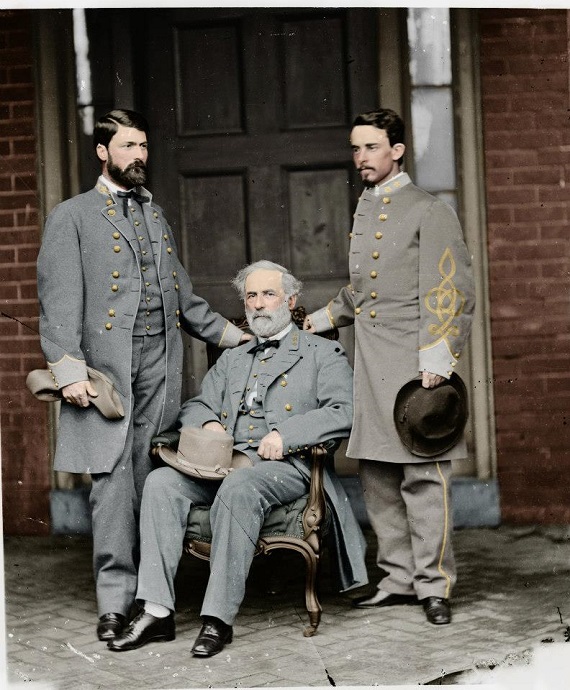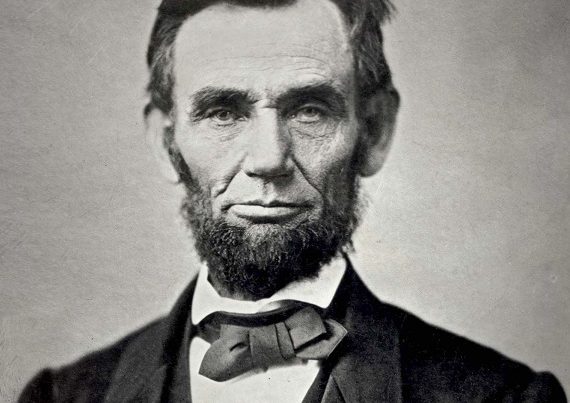
A frequent argument against Confederate monuments is a “sound bite” of a quote from General Robert E. Lee in 1869 in some variation to “I think it wiser not to keep open the sores of war.” The time of the event and the Monument Movement is significant. Understanding this connection changes the meaning of the “sound bite” entirety. Here’s the context.
The letter cited is Lee’s decline to attend a reunion of Gettysburg veterans from the Gettysburg Battlefield Memorial Association. The Gettysburg Battlefield Memorial Association was chartered by the Commonwealth of Pennsylvania on 13 April 1864, to preserve the Gettysburg Battlefield.[1] David McConaughy was the president.[2]
Lee wrote on 4 August 1869 his reply to David McConaughy’s invitation to participate in the “reunion of Gettysburg veterans, who identified specific, historic battlefield sites, and offered personal accounts of the engagement.”[3] Many letters in the Gettysburg College, Gett Digital collection of these letters are responses to David McConaughy’s invitation. They declined to attend for a variety of reasons, some even naming others to consider inviting for the desired information.[4] Lee was not alone in his absence from the event. The entirely of Lee’s letter is:
“Absence from Lexington has prevented my receiving until to-day your letter of the 26th [July 1869], inclosing (sic) an invitation from the Gettysburg Battle-field (sic) Memorial Association, to attend a meeting of the officers engaged in that battle at Gettysburg, for the purpose of marking upon the ground by enduring memorials of granite the positions and movements of the armies on the field. My engagements will not permit me to be present. I believe if there, I could not add anything material to the information existing on the subject. I think it wiser, moreover, not to keep open the sores of war but to follow the examples of those nations who endeavored to obliterate the marks of civil strife, to commit to oblivion the feelings engendered.”[5]
In the letter, Lee states he believes that there is nothing he can add to his locations in the war – likely because many others could add that in the discussion. His locations are well documented in the records.
Some make the case questioning why Lee would return Gettysburg as many consider the battle his most significant loss, both professionally and personally? This may play a role in his decision as well, though the author is not aware of any evidence supporting or opposing this argument.
Furthermore, his comment to the “open the sores of war but to follow the examples of those nations who endeavored to obliterate the marks of civil strife”[6] is possibly directed either to monuments in general or specifically to the Union monuments.
Out of 423 Union monuments in the Blevins study for “Forever in Mourning: Union and Confederate Monuments 1860-1920” (Nineteenth Century Magazine, Fall 2019), there are 52 Union monuments and three Confederate monuments in 1869. Two from in 1867 and one in 1869.[7] That year, Union monuments outnumbered the Confederates monuments by over 17 to 1. It was not until 1914 did the monuments have equal numbers.[8]
In the same light, Lee’s second son, William Henry Fitzhugh Lee, responding to the same Gettysburg Battlefield Memorial Association request, shared his father’s opinion in “that if the nation is to continue as a whole it is better to forget and forgive each other than perpetuate in granite proofs of its civil wars (sic).”[9] Is this his reference to the number of Union monuments going up across the United States?
Was 1869 just too close to the end of the war to memorialize? Robert E. Lee died in 1870, likely saying nothing more on the monuments.
However, Fitzhugh Lee’s view apparently changed over time. In April 1873, he wrote the President of the City Council of Richmond to advocate for the J.E.B. Stuart monument. Maybe his reference to “granite proofs of” the war referred to the battlefields? To the dead, he dedicated several Confederate monuments.
In June 1877, after turning down the first invitation, Fitzhugh Lee spoke as the orator of the day at the Confederate monument dedication at Hagerstown, Maryland. He spoke of the “memory of 2,500 brave men who slept their last sleep.[10] In 1881, Fitzhugh Lee spoke at the Army of Northern Virginia Monument dedication in Metairie Cemetery in Louisiana.[11]
In May 1889, Fitzhugh Lee spoke as the Orator of the Day at Alexandria’s monument dedication, Virginia Confederate Monument to “Alexandria’s Dead”, [12] one of two dedicated to the Confederates in 1889. His comments included the following, “Federal and Confederate soldiers are citizens of one country.”[13]
Fitzhugh Lee further noted the Monument Movement in his oration, which included 35 Confederate monuments in 1889 and at least 175 monuments by 1900.[14] In Alexandria, he mentioned in the ceremony that, “Northern Organizations in honor of the devotion to the Union of the States by Federal soldiers are right and proper, and celebrations in the South by Southern Soldiers in honor of the memory of those who died in defense of their States, their homes, and their people should be equally recognized as the merited tribute to their valor…”[15]
At the dedication of the Robert E. Lee monument in Richmond in 1890, General Early described Robert E. Lee as needing “no monument except to show the love of the people in the South for him.” Fitzhugh Lee was in the audience.[16]
In June 1895, Fitzhugh Lee was one of several former Confederate Generals praising Chicago for a monument they dedicated to the Confederate dead who died in prison there.[17]
Perhaps Robert E. Lee did not seek monuments for himself, as Gettysburg monuments would be to him and his locations. Maybe he saw the Union monuments as keeping wounds open. He died too soon for further comment. However, his son did speak at multiple dedications. It is apparent, though, that Robert E. Lee’s “sound bite” statement is not a condemnation of Confederate monuments.
Monuments are not for what we are now. They are for where we were and what the community was then. Monuments are stone bookmarks. They prompt you by reminding you of past events. They are meant for you to learn your history. After seeing one, you go look up something about the person, place, event, that it memorializes. Then you learn your history.
Bibliography:
Blevins, Ernest Everett, “Forever in Mourning: Union and Confederate Monuments 1860-1920,” available at: https://www.academia.edu/41329543/Forever_in_Mourning_Union_and_Confederate_Monuments_1860-1920
“Civil War Era Collection (1830 – 1877),” https://gettysburg.contentdm.oclc.org/digital/collection/p4016coll2/search/searchterm/McConaughy%2C%20David/field/recipi/mode/exact/conn/and (accessed 15 July 2020)
“Gettysburg Battlefield Memorial Association,” https://brbl-dl.library.yale.edu/vufind/Author?author=Gettysburg+Battlefield+Memorial+Association (accessed 15 July 2020)
“Hagerstown Memorial Celebration,” The Baltimore (Maryland) Sun, 13 June 1877, 4.
“In Honor of Gen. Lee,” Chicago (Illinois) Tribune, 30 May 1890, 1.
“In Old Alexandria,” St. Louis (Missouri) Globe-Democrat, 25 May 1889, 1.
“Robert E. Lee to David McConaughy, 5 August 1869,” Available at https://gettysburg.contentdm.oclc.org/digital/collection/p4016coll2/id/841/ (accessed 15 July 2020)
“William Henry Fitzhugh Lee to David McConaughy, 14 August 1869,” https://gettysburg.contentdm.oclc.org/digital/collection/p4016coll2/id/844/rec/4 (accessed 15 July 2020)
“David McConaughy,” https://www.legis.state.pa.us/cfdocs/legis/BiosHistory/MemBio.cfm?ID=5164&body=S (accessed 15 July 2020)
“The Chivalry of Chicago,” The (Anderson, South Carolina) Intelligencer, 5 June 1895, p. 4
“David McConaughy,” https://www.legis.state.pa.us/cfdocs/legis/BiosHistory/MemBio.cfm?ID=5164&body=S (accessed 15 July 2020)
“The A.N.V. Monument,” The Louisiana Capitolian (Baton Rouge), 8.
“Unveiling of the Monument,” Alexandria (Virginia) Gazette and Virginia Advertiser,” 24 May 1889, 2.
[1] “Gettysburg Battlefield Memorial Association,” https://brbl-dl.library.yale.edu/vufind/Author?author=Gettysburg+Battlefield+Memorial+Association (accessed 15 July 2020)
[2]“David McConaughy,” https://www.legis.state.pa.us/cfdocs/legis/BiosHistory/MemBio.cfm?ID=5164&body=S (accessed 15 July 2020)
[3]“David McConaughy,” https://www.legis.state.pa.us/cfdocs/legis/BiosHistory/MemBio.cfm?ID=5164&body=S
[4] “Civil War Era Collection (1830 – 1877),” https://gettysburg.contentdm.oclc.org/digital/collection/p4016coll2/search/searchterm/McConaughy%2C%20David/field/recipi/mode/exact/conn/and (accessed 15 July 2020)
[5]“Robert E. Lee to David McConaughy, 5 August 1869,” Available at https://gettysburg.contentdm.oclc.org/digital/collection/p4016coll2/id/841/ (accessed 15 July 2020)
[6]“Robert E. Lee to David McConaughy, 5 August 1869,” Available at https://gettysburg.contentdm.oclc.org/digital/collection/p4016coll2/id/841/ (accessed 15 July 2020)
[7]Blevins, Ernest Everett, ““Forever in Mourning: Union and Confederate Monuments 1860-1920,” available at https://www.academia.edu/41329543/Forever_in_Mourning_Union_and_Confederate_Monuments_1860-1920
[8]Blevins, Ernest Everett, ““Forever in Mourning: Union and Confederate Monuments 1860-1920,” available at https://www.academia.edu/41329543/Forever_in_Mourning_Union_and_Confederate_Monuments_1860-1920
[9] “William Henry Fitzhugh Lee to David McConaughy, 14 August 1869,” https://gettysburg.contentdm.oclc.org/digital/collection/p4016coll2/id/844/rec/4 (accessed 15 July 2020)
[10] “Hagerstown Memorial Celebration,” The Baltimore (Maryland) Sun, 13 June 1877, 4.
[11] “The A.N.V. Monument,” The Louisiana Capitolian (Baton Rouge), 8.
[12]“In Old Alexandria,” St. Louis (Missouri) Globe-Democrat, 25 May 1889, 1.
[13]“In Old Alexandria,” St. Louis (Missouri) Globe-Democrat, 25 May 1889, 1.
[14]Blevins, Ernest Everett, ““Forever in Mourning: Union and Confederate Monuments 1860-1920,” available at https://www.academia.edu/41329543/Forever_in_Mourning_Union_and_Confederate_Monuments_1860-1920
[15] “Unveiling of the Monument,” Alexandria (Virginia) Gazette and Virginia Advertiser,” 24 May 1889, 2.
[16] “In Honor of Gen. Lee,” Chicago (Illinois) Tribune, 30 May 1890, 1.
[17] “The Chivalry of Chicago,” The (Anderson, South Carolina) Intelligencer, 5 June 1895, p. 4







It’s simply not the case that monuments are neutral reminders of history, inspiring only curiosity for further facts. Monuments make a statement about honor. Of course there are rare examples of monuments intended as reminders of shame, but it almost calls into question the definition of monument to consider them. Your arguments concerning the interpretation of Lee’s words offer more conjecture than evidence. Later statements don’t always illuminate the intent of prior statements, sometimes indicating a change of perspective. (Note Lindsey Graham on Trump, for example.) At any rate the important thing about monuments is that they are rarely forever. At some point they will be found irrelevant or contrary to current values, and either transferred to locations more suited to history and less to statements of honor and approval… or destroyed. As often as not, the destruction is a statement of disapproval of the values the monument glorifies.